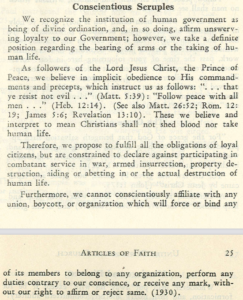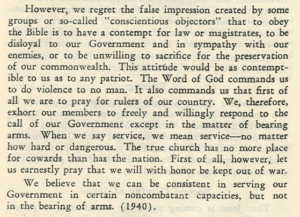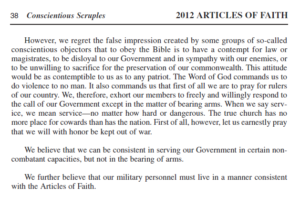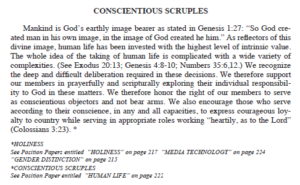Then & Now: Changes to the United Pentecostal Articles of Faith: Conscientious Scruples. Comparing 1952 to 2022.
The United Pentecostal Church formed in 1945. Here we will examine what the Articles of Faith have stated about conscientious scruples.
As a side note before we go into the current topic, in the third installment of this series I wrote, in regard to the two groups who merged to form the UPCI in 1945, “David Bernard, the current General Superintendent, has downplayed the fact that the two groups had differences in beliefs.” Quotes were shared from Stanley Chambers and W.T. Witherspoon, showing that there were differences in beliefs, to the extent that one stated that they “diametrically disagreed” on some issues. There were apparently enough differences that the PAJC shared that the following year after the merger, there were ministers who broke away from the UPCI. (Yes, the PAJC is still around.)
From the PAJC Articles of Faith and Constitution: “In the year of 1931 the P.A.W. and the Apostolic Churches of Jesus Christ merged together forming the P.A.J.C. and continued until 1945. Then in the year of 1945 the P.AJ.C. and the Pentecostal Churches, Inc. (P.C.I.) merged together forming what is now called the United Pentecostal Church (D.P.C.). [Note: that should be U.P.C.] From 1945 to approximately August, 1946 this continued. Then a group of brethren who became dissatisfied revived the charter of the P.AJ.C. and continued on with the charter. In the spring of 1948 the Churches of the Lord Jesus Christ met with the brethren of the P.A.J.C. and a proposal of merger was proposed. In August, 1948 the merger became complete.”


Above is how conscientious scruples appeared in the 1952 UPCI Manual. David Bernard explains this section in Understanding the Articles of Faith: Revised Edition. “At the time of the merger, such status was available under United States law only to people who were members of a religion that took such a position. Now, however, it is available in time of a draft if individuals can simply show that they have a personal scruple, whether or not they belong to an organization that advocates this approach. Prior to the merger, some ministers were jailed for refusing to serve in the military because of their convictions. According to Nathaniel Urshan, general superintendent of the UPCI, this article was designed to enable ministers to serve in the military as conscientious objectors and to instruct them to do so rather than refusing to enter the military when drafted.”

In 1984, the following sentence was added at the end, “We further believe that our military personnel must live in a manner consistent with the Articles of Faith.” This most likely is in reference to holiness standards. The quote above shows part of this section, where the sentence had been added.

On August 29, 2012, David Bernard announced in an email, “In 2011 the General Conference approved two amendments to the Articles of Faith. To be adopted, all such amendments must be approved by a two-thirds vote in two-thirds of the districts. The article entitled ‘Atonement’ was approved by 100% of the districts and the amendment to ‘Conscientious Scruples’ was approved by 79% of the districts, so both are now part of the Articles of Faith.” This change was a complete overhaul of the section as you will see below. The new version first appeared in the 2013 UPCI Manual.

David Bernard, in his book Understanding the Articles of Faith: Revised Edition, had this to say about the changes, “While the purpose of the former article was to ensure that United Pentecostals could qualify for conscientious objector status in the military, the language expressed it as the organization’s view rather than merely the protection of a minority view. A General Board discussion in 1992 revealed that a strong majority of its members held this view, but a similar discussion in 1998 disclosed significant differences of opinion. In 1996 the General Conference called for a committee to study this matter, but the committee never reached agreement on an amendment. In 1998 the General Board decided that the matter could be handled by a position paper saying it was a matter of personal conviction. In 2009 the General Board determined that the statement in the Articles of Faith did not represent a consensus and adopted a proposal to replace it. In 2010 the General Board decided to present the new article to the 2011 General Conference, where it passed. The new article was ratified by the districts and became effective in 2012.”
To read the entire 1952 UPCI Articles of Faith, go here.
Then & Now: Changes to the United Pentecostal Articles of Faith Part 1: Public School Activities
Then & Now: Changes to the United Pentecostal Articles of Faith Part 2: Holiness
Then & Now: Changes to the United Pentecostal Articles of Faith Part 3: Fundamental Doctrine
Then & Now: Changes to the United Pentecostal Articles of Faith Part 4: Atonement
Then & Now: Changes to the United Pentecostal Articles of Faith Part 5: Conscientious Scruples
********
Shop at our Amazon store! As an Amazon Influencer, this website earns from qualifying purchases.

